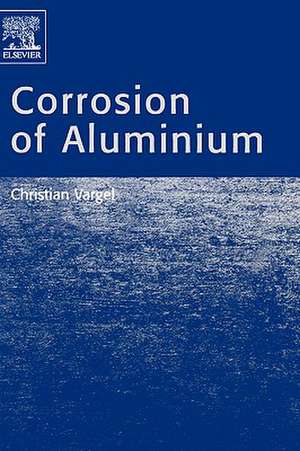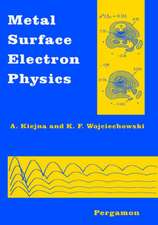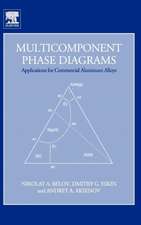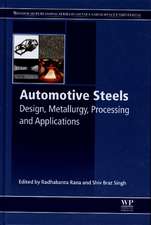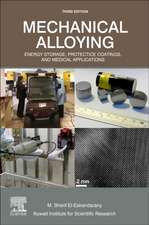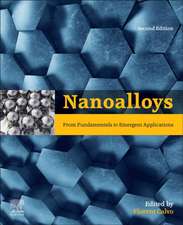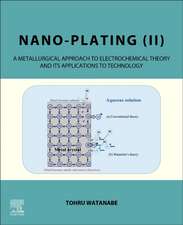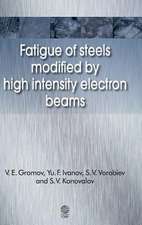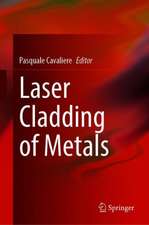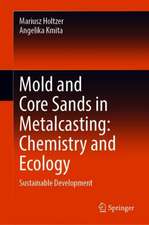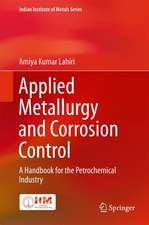Corrosion of Aluminium
Autor Christian Vargelen Limba Engleză Hardback – oct 2004
The author Christian Vargel, has adopted a practitioner approach, based on the expertise and experience gained from a 40 year career in aluminium corrosion This approach is most suitable for assessing the corrosion resistance of aluminium- an assessment which is one of the main conditions for the development of many uses of aluminium in transport, construction, power transmission etc.
- 600 bibliographic references provide a comprehensive guide to over 100 years of related study
- Providing practical applications to the reader across many industries
- Accessible to both the beginner and the expert
| Toate formatele și edițiile | Preț | Express |
|---|---|---|
| Hardback (2) | 1092.71 lei 5-7 săpt. | |
| ELSEVIER SCIENCE – oct 2004 | 0.00 lei Indisponibil | |
| ELSEVIER SCIENCE – 6 mai 2020 | 1092.71 lei 5-7 săpt. |
Preț: 672.53 lei
Preț vechi: 1188.82 lei
-43% Nou
Puncte Express: 1009
Preț estimativ în valută:
128.68€ • 134.37$ • 106.27£
128.68€ • 134.37$ • 106.27£
Carte tipărită la comandă
Preluare comenzi: 021 569.72.76
Specificații
ISBN-13: 9780080444956
ISBN-10: 0080444954
Pagini: 700
Ilustrații: illus; bibliog
Dimensiuni: 165 x 240 x 42 mm
Greutate: 1.06 kg
Editura: ELSEVIER SCIENCE
ISBN-10: 0080444954
Pagini: 700
Ilustrații: illus; bibliog
Dimensiuni: 165 x 240 x 42 mm
Greutate: 1.06 kg
Editura: ELSEVIER SCIENCE
Public țintă
Engineers/technicians in the aluminium transformer industry; Students and professors studying materials science, mechanical engineering and structural engineeringCuprins
1. Historical reviews
2. Physical properties
3. Advantages of aluminium
4. Alloys series of aluminium
5. Cast aluminium alloys
6. Wrought aluminium alloys
7. Selection criteria
8. The corrosion of aluminium
9. Notion of potential
10. Oxide film and passivity
11. Disturbed surface
12. Influence of composition
13. Uniform corrosion
14. Pitting corrosion
15. Intergranular corrosion
16. Exfoliation corrosion
17. Stress corrosion
18. Fatigue corrosion
19. Filiform corrosion
20. Crevice corrosion
21. Fretting corrosion
22. Waterline corrosion
23. Erosion cavitation
24. Microbiologically corrosion
25. Galvanic corrosion
26. Corrosion products
27. Parameters
28. Corrosion testing
29. Protection of aluminium
30. Grades series 1XXX
31. 2XXX series alloys
32. 3XXX Serie alloys
33. 5XXX Series alloys
34. 6XXX Series alloys
35. 7XXX Series without copper
36. 7XXX Series with copper
37. Aluminium-lithium alloys
38. Aluminium-casting alloy
39. Atmospheric corrosion
40. Parameters
41. Types of atmospheres
42. Forms of corrosion
43. Resistance of aluminium
44. Corrosion in water
45. Corrosion in freshwater
46. Corrosion in seawater
47. Corrosion in brackish waters
48. Oxides and peroxides
49. Hydrogen, nitrogen
50. Metalloids and halides
51. Inorganic bases
52. Inorganic acids
53. Inorganic Salts
54. Hydrocarbons
55. Halogen derivatives
56. Alcohols, ethers, thiols
57. Amines
58. Aldehydes and ketones
59. Carboxylic acids
60. Other organic products
61. Corrosion in Soil
62. Effect of stray currents
63. Fertilizers and Herbicides
64. Construction Materials
65. Food industry
66. Cleaning of aluminium
67. Behavior in fire
68. Dangerous products
2. Physical properties
3. Advantages of aluminium
4. Alloys series of aluminium
5. Cast aluminium alloys
6. Wrought aluminium alloys
7. Selection criteria
8. The corrosion of aluminium
9. Notion of potential
10. Oxide film and passivity
11. Disturbed surface
12. Influence of composition
13. Uniform corrosion
14. Pitting corrosion
15. Intergranular corrosion
16. Exfoliation corrosion
17. Stress corrosion
18. Fatigue corrosion
19. Filiform corrosion
20. Crevice corrosion
21. Fretting corrosion
22. Waterline corrosion
23. Erosion cavitation
24. Microbiologically corrosion
25. Galvanic corrosion
26. Corrosion products
27. Parameters
28. Corrosion testing
29. Protection of aluminium
30. Grades series 1XXX
31. 2XXX series alloys
32. 3XXX Serie alloys
33. 5XXX Series alloys
34. 6XXX Series alloys
35. 7XXX Series without copper
36. 7XXX Series with copper
37. Aluminium-lithium alloys
38. Aluminium-casting alloy
39. Atmospheric corrosion
40. Parameters
41. Types of atmospheres
42. Forms of corrosion
43. Resistance of aluminium
44. Corrosion in water
45. Corrosion in freshwater
46. Corrosion in seawater
47. Corrosion in brackish waters
48. Oxides and peroxides
49. Hydrogen, nitrogen
50. Metalloids and halides
51. Inorganic bases
52. Inorganic acids
53. Inorganic Salts
54. Hydrocarbons
55. Halogen derivatives
56. Alcohols, ethers, thiols
57. Amines
58. Aldehydes and ketones
59. Carboxylic acids
60. Other organic products
61. Corrosion in Soil
62. Effect of stray currents
63. Fertilizers and Herbicides
64. Construction Materials
65. Food industry
66. Cleaning of aluminium
67. Behavior in fire
68. Dangerous products
Recenzii
"A welcome addition to technical libraries, Corrosion of Aluminium takes on this challenging topic in both scientific and practical terms, offering an all-inclusive analysis of the subject—a corrosion classic in every sense." -- Light Metal Age
"This new edition highlights the practical and general aspects of the corrosion of aluminum alloys. Chapters help readers new to the topic understand the metallurgical, chemical, and physical features of aluminum alloys. The author adopts a practitioner styled approach that is based on the expertise he has gained during a 40-year career in aluminum corrosion. The book assesses the corrosion resistance of aluminum, a key metric recognized as one of the main conditions for the development of many uses of aluminum in transport, construction, power transmission, and more." --ICP
"This new edition highlights the practical and general aspects of the corrosion of aluminum alloys. Chapters help readers new to the topic understand the metallurgical, chemical, and physical features of aluminum alloys. The author adopts a practitioner styled approach that is based on the expertise he has gained during a 40-year career in aluminum corrosion. The book assesses the corrosion resistance of aluminum, a key metric recognized as one of the main conditions for the development of many uses of aluminum in transport, construction, power transmission, and more." --ICP
